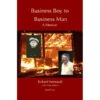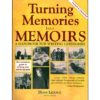
3 Decisions That Sustain Your Memoir Writing
I want to share with you three decisions you can make to help you to succeed more quickly and easily at memoir writing.
Over the last two decades, I have coached many, many writers—more writers than I can remember. In those years, I have seen some people soar with the experience—it’s as if they can do no wrong—while unfortunately, I have seen others coach with me for periods of time without making any apparent change or progress.
This experience has enabled me to come up with three decisions a person who wants to succeed at memoir writing must make. These decisions will help you to reach publication faster than you can without them.
1. You must resolve to commit to the discipline necessary to succeed.
[Free Membership required to read more. See below. ]
We'd love to have you access this content. It's in our members-only area, but you're in luck: becoming a member is easy and it's free.
Already a Member?
Not a Member Yet?

Going Deeper in a Memoir: Look at “Life’s Failed Contracts”
This post is about going deeper in a memoir, deeper even than you thought you could go when you started. This may be hard, but take a look at the contracts with life we make and the terrible disappointment that inevitably comes from making them. All of us at some time or other have made such a contract with life—in fact, we make them over and over again until we finally grow up and become present to the unfolding reality. [Free Membership required to read more. See below. ]
We'd love to have you access this content. It's in our members-only area, but you're in luck: becoming a member is easy and it's free.
Already a Member?
Not a Member Yet?

Show Don’t Tell Your Characters, or Don’t Describe Your Characters–Show Them!
The old adage “Show, don’t tell your characters!” is as true as ever. It is one technique that will always improve your writing. I admit that there is some great writing that makes a precedent for “tell,” but as a rule, “show” is more effective.
1. Your computer and its keyboards are your movie camera. Show Don’t Tell Your Characters.
In a film, a director ( that’s you!) doesn’t have an actor go on screen to tell the audience that someone is angry. Instead, he shows the character in a scene where anger is in action. [Free Membership required to read more. See below. ]
We'd love to have you access this content. It's in our members-only area, but you're in luck: becoming a member is easy and it's free.
Already a Member?
Not a Member Yet?

Writing Hooks to Open a Paragraph or Chapter
“How do I start a chapter so that it has writing hooks that capture the reader’s interest?” you ask.
In this post, I give you three surefire ways to open a chapter or even the whole of your memoir. You’ll use one of these writing hooks time after time.
These three methods involve creating curiosity in your reader. This curiosity via writing hooks is easy for you to ignite so that your reader will want to read your story.
The first of the writing hooks
The first technique is to start with a conversation, but you must start with the second half of that conversation and not the first part.
[Free Membership required to read more. See below. ]
We'd love to have you access this content. It's in our members-only area, but you're in luck: becoming a member is easy and it's free.
Already a Member?
Not a Member Yet?

Don’t Worry About a Thing / Katherine Sullivan
Denis Ledoux: At The Memoir Network, we had the pleasure of working with Katherine Sullivan for several years as she edited her memoir, Don’t Worry About a Thing, with one of our editors, Frances King, and focused on book production with Sally Lunt. Because of her insightful articulation of her life experience, I am delighted she agreed to do the following interview (conducted by email.)
Denis: Can you tell our readers—your fellow writers—what your book is about and why you were impelled to write it? What was driving you to spend the time, energy and money to get this book out into the world?
Katherine: Don’t Worry About a Thing is a coming-of-age memoir about life in a small Maine town in the middle of the twentieth century. As a child of a Greek immigrant and a Maine country girl, I tried to find my place in the world. Not all immigrant stories are success stories. I was impelled to write this book to help me find meaning after a childhood spent with a father whose gambling addiction affected every aspect of my life. I searched for answers in an unstable world, and writing was a place where I could question and discover who I was and where I fit in the world. My personal therapy.
Denis: Tell us about your writing process and how long you worked on this memoir.
Katherine: I began actively working on this book in my fifties, so about twenty years, but I knew from when I was a young girl that I wanted to write. There were long breaks when my life in the present got in the way of my writing about the past. I knew though, that I would finish, and to get me motivated during those dry spells, I took writing workshops at various intervals.
[Free Membership required to read more. See below. ]
We'd love to have you access this content. It's in our members-only area, but you're in luck: becoming a member is easy and it's free.
Already a Member?
Not a Member Yet?

Writing Process Steps—Linger With Your Story
One of the writing process steps is to linger with your story. Many, and perhaps most, people write too fast. I don’t mean that they end up with a text characterized by sloppy grammar, spelling problems and chronology issues—although that may be the case, of course.
No, what I mean is that they push through the process of writing their stories much too quickly. They end up with only a part of the story they could have written had they lingered.
So many times in my workshops, I have found it easy to tell those manuscripts that have been lingered over from those that have not. As somebody’s face reveals Irish ancestry or Italian heritage, a piece of writing reveals its past.
There is a quality to a piece that has been rushed that is easily discernible to anyone who has learned to write more slowly. So…learn to linger with your story.
One of the essential writing process steps
1. When you don’t take the time to linger with your story, you generally are unable to feel the full import of your memoir.
[Free Membership required to read more. See below. ]
We'd love to have you access this content. It's in our members-only area, but you're in luck: becoming a member is easy and it's free.
Already a Member?
Not a Member Yet?

Writing Feelings into Your Memoir
Recently, David asked in an email about “writing feelings into your memoir,” about writing a memoir that, if I am understanding him right, is not all details and facts.
Below is my response which can serve as a stand-alone article to help you write your own memoir.
Leave a comment below expressing your experience of writing feelings into your memoir.
—
Here are some of my suggestions for writing feelings into your memoir:
[Free Membership required to read more. See below. ]
We'd love to have you access this content. It's in our members-only area, but you're in luck: becoming a member is easy and it's free.
Already a Member?
Not a Member Yet?

The Theme-focused Memoir
While many of the people whom I have helped to write a memoir have come ostensibly to write about their lives – to celebrate some achievement, I would say that many of these people are also writing a mission-driven memoir, a theme-focused memoir.
Behind the desire to tell about their lives, there is some intent to promote a point of view. This comes under many guises. Generally, of course, this point of view is called “theme.”
The theme-focused memoir is the most common model.
Writing a manuscript only of one’s experience—the dates, the facts, the activities—may often not enough to entice the reader—at least, it will not interest the reader who is not family and friends. [Free Membership required to read more. See below. ]
We'd love to have you access this content. It's in our members-only area, but you're in luck: becoming a member is easy and it's free.
Already a Member?
Not a Member Yet?

Should You Create an Outline or a Memory List for your Memoir?
DL: An outline or a Memory List? This is a perennial favorite with the search engines. I consider it to be a foundational post whose info can guide you to success. I hope you enjoy it.
A Memory List is far superior to an outline!
For some writers, there comes a moment in writing a memoir when the audacity of the undertaking hits them. Perhaps they think doorslammers like: “This can take forever.” “Writing a memoir will never pay for itself.” “I can’t afford to do this!” They reach for certainty. And that certainly if often a reversion to essay and report writing. They want an outline to assure the task gets done right. So, an outline or a Memory List?
The following is a comment to someone who asked in the Memoir Forum if she should create an outline and how to know when the page and chapters were the right length.
1. Do not write a memoir from an outline.
I do not write from an outline. Instead, I create a Memory List as outlined in Chapter 2 of Turning Memories Into Memoirs. The Memory List helps you to follow the promptings of the unconscious rather than the dictates of the conscious mind as happens with an outline. (An outline is great for an essay—”The Three Causes of the American Civil War”— but it is the death of an exploratory memoir.) So…
[Free Membership required to read more. See below. ]
